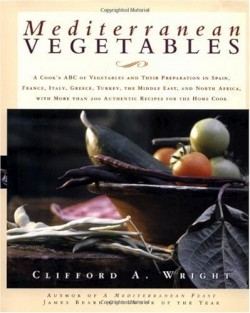
Mediterranean Vegetables
A Cook?s ABC of Vegetables and Their Preparation in Spain France Italy Greece Turkey the Middle East and North Africa
Mediterranean cooking is alluring and now, more than ever, novice gourmets can imitate foods once only available to international travelers. This book originated as a simple appendix to A Mediterranean Feast, winner of the James Beard Cookbook of the Year Award. Over time, the author realized that he had gathered enough information for a second collection of recipes from the area.
Wright calls himself “A vegophile, someone who simply loves the tastes of vegetables and who, when his hand is on the skillet, thinks gastronomically rather than ethically.” Traditionally, Mediterranean cooks use meat as a condiment rather than as a main course. The author explains the reasons for this tradition and connects them anecdotally to history, economics, and the development of society. While Wright liberally quotes from such famous vegetarians as Leonardo da Vinci, this is not strictly a vegetarian cookbook.
Mediterranean Vegetables is a reference book for cooks; it contains essential information about the vegetables used in both “old world” and “new world” Mediterranean cuisines. It gives the name of each vegetable in various languages, its botanical Latin binomial (genus), and short paragraphs on its history and origin, as well as practical information on growing, harvesting, storing, and cooking. The practical information makes this a welcome addition to any cookbook collection: all of it could be applied to any type of cooking. Wright’s sensible approach to food preparation is irresistible.
Americans, despite the United States Department of Agriculture’s long repeated suggestions, have only recently acknowledged the importance of eating more vegetables. Wright’s encyclopedia of vegetables offers easy explanations and over 200 recipes for healthier, tastier eating. He includes recipes for standard fare such as rice pilaf, fava beans, spinach, grape leaves, and omelettes. The delights are in the surprising combinations of foods-Artichokes Stuffed with Pomegranate Syrup, Boiled Broccoli with Brown Butter and Parmesan Cheese, and Macaroni with Eggplant.
Reviewed by
Pam Kingsbury
Disclosure: This article is not an endorsement, but a review. The publisher of this book provided free copies of the book to have their book reviewed by a professional reviewer. No fee was paid by the publisher for this review. Foreword Reviews only recommends books that we love. Foreword Magazine, Inc. is disclosing this in accordance with the Federal Trade Commission’s 16 CFR, Part 255.
